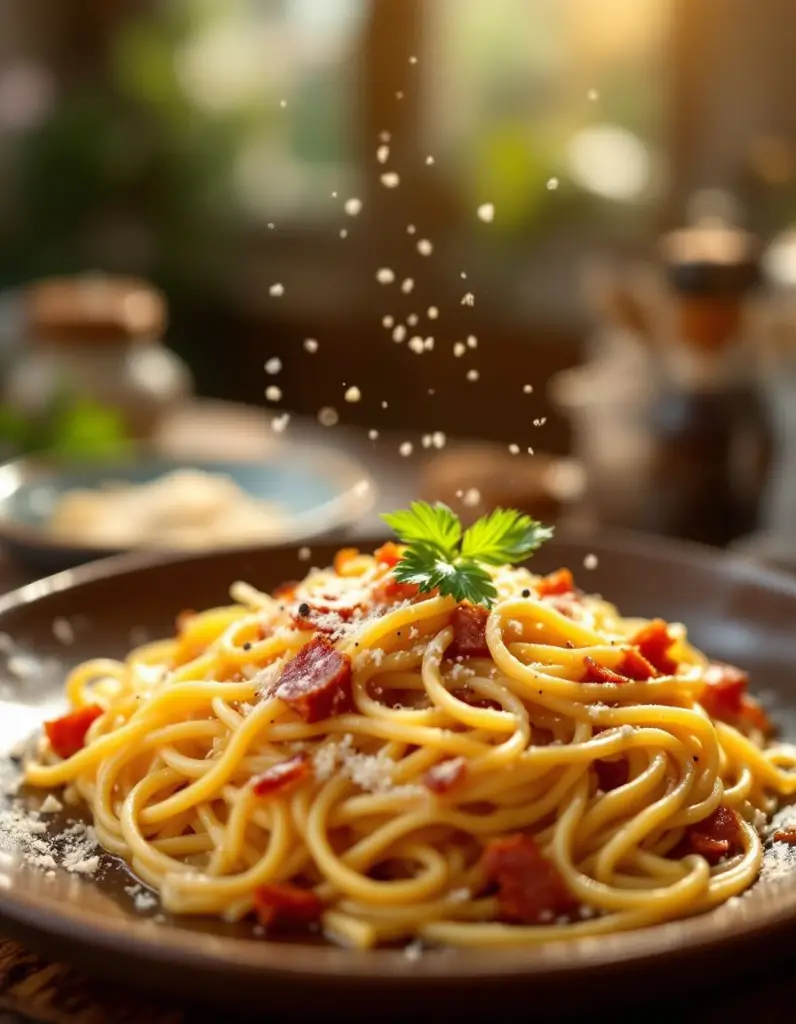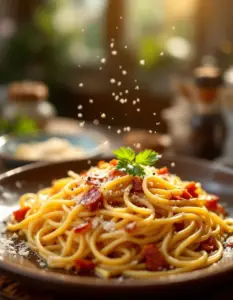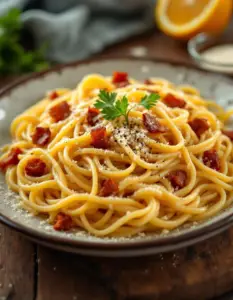Classic Spaghetti Carbonara: A Timeless Italian Delight
Classic spaghetti carbonara is a dish that epitomizes Italian comfort food, rich in flavor and tradition. With its creamy texture and the delightful salty kick from guanciale or pancetta, this pasta dish brings a taste of Rome right to your dinner table. The simplicity of its ingredients—spaghetti, eggs, cheese, and cured pork—allows each component to shine, creating a harmonious blend that is both satisfying and indulgent.
As you twirl the strands of spaghetti around your fork, the shiny coating of the sauce clings perfectly, creating a velvety mouthfeel that is irresistible. Each bite reveals the slight crispness of the pork, which contrasts beautifully with the silky sauce. The fragrance of freshly cracked black pepper adds an invigorating aroma, enhancing the overall experience. This classic meal not only fills your tummy but also warms your heart, making it perfect for family dinners or special occasions.
Quick Recipe Highlights
- Flavor Profile: Rich, savory, with a hint of pepper and cheese.
- Texture: Creamy, with a satisfying chew from the al dente pasta.
- Aroma: Inviting and robust, featuring cured pork and freshly cracked black pepper.
- Visual Appeal: A glossy pasta dish adorned with flecks of black pepper and golden cheese.
- Skill Level Needed: Intermediate; requires proper timing to blend the ingredients without scrambling the eggs.
- Special Equipment: A large pot for boiling pasta and a frying pan for cooking the pork.
Recipe Overview
- Difficulty Level: This recipe sits at a medium difficulty. It demands attention for precise timing and technique, especially when combining the warm pasta with the egg mixture without cooking the eggs fully.
- Category: This dish is ideal for main courses, making it a staple in Italian households, particularly for families gathering at the dinner table.
- Cuisine: Originating from Italy, specifically Rome, spaghetti carbonara is a testament to the brilliance of Italian cuisine—simple ingredients transformed into something extraordinary.
- Cost: Generally, this recipe is cost-effective, requiring basic pantry staples and a few fresh items; it can be made for under $15, depending on ingredient quality.
- Season: Carbonara is perfect year-round but is particularly comforting in winter and fall when hearty meals are cherished.
- Occasion: Ideal for any occasion, from casual family dinners to festive gatherings with friends, carbonara is sure to impress anyone at the table.
Why You’ll Love This Recipe
The classic spaghetti carbonara has a universal appeal due to its wonderful taste and rich texture. The combination of creamy egg sauce and crispy pancetta makes for an indulgent dish that feels luxurious yet is simple to prepare. You can prepare it in under 30 minutes if you get your ingredients ready in advance, making it a perfect weeknight dinner.
Not only is carbonara incredibly delicious, but it also has nutritional benefits. Eggs provide a good source of protein while the pasta offers carbohydrates for energy. Using a quality cheese such as Pecorino Romano adds calcium and other essential nutrients, making this dish more than just comfort food.
This recipe is also a fantastic choice for entertaining. It is easy to replicate for larger gatherings, and its impressive presentation will leave your guests raving about your culinary skills. Sharing delicious meals builds connections and creates lasting memories around the table.
Moreover, spaghetti carbonara is versatile and cost-effective compared to dining out. You can easily make this gourmet dish at home without overspending, allowing you to enjoy a fine Italian meal whenever you crave it.
Finally, the cultural heritage of spaghetti carbonara enhances its appeal. Each bite is intertwined with the essence of Italian tradition, connecting you to the rich culinary history of Rome, making every forkful more meaningful.
Historical Background and Cultural Significance
The origins of spaghetti carbonara are somewhat shrouded in mystery. It’s widely believed to have emerged after World War II when the American troops stationed in Italy combined their rations of bacon and eggs with pasta, creating a dish that quickly became beloved among locals. The simplicity and heartiness of carbonara made it a symbol of resourcefulness in the culinary arts.
This dish holds great significance in Italian culinary culture, especially in Rome, where it is often considered a staple. The combination of pasta and eggs pays homage to Italy’s agricultural heritage, showcasing how basic ingredients can transform into a harmonious meal. Today, many Roman restaurants pride themselves on their carbonara, each boasting their unique twist while still adhering to the classic method.
Over the years, spaghetti carbonara has evolved, incorporating variations that highlight local ingredients and individual chef preferences. Despite these adaptations, the fundamental elements remain the same, ensuring the integrity of this beloved dish is maintained.
Carbonara also has numerous regional variations across Italy. Some argue for the inclusion of cream, while others insist that real carbonara must stay true to its origins—pasta, eggs, and pork. This lively debate adds to the charm and cultural richness surrounding the dish, making it more than just a meal but a topic of passionate discussion.
Ingredient Deep Dive
Spaghetti
Spaghetti is the backbone of this dish, providing the necessary structure to hold the sauce. It is a traditional Italian pasta that has a long and slender shape, making it perfect for twirling. Choosing high-quality durum wheat spaghetti can enhance the texture and taste of the dish significantly.
Nutritional benefits include being a good source of carbohydrates essential for energy. When selecting spaghetti, look for brands that use 100% semolina to ensure you receive the best quality. Store uncooked spaghetti in a cool, dry place in an airtight container to prolong its shelf life.
Pancetta or Guanciale
Pancetta, an Italian cured meat similar to bacon, delivers the salty, umami flavor central to carbonara. Guanciale, made from pork cheek or jowl, is the traditional choice and provides a richer taste and texture. Both options elevate the dish, adding depth that complements the creamy sauce.
These meats are rich in flavor and fats, contributing to the overall richness of the dish. When selecting, opt for high-quality cuts from a reputable butcher. They should be stored in the refrigerator and consumed within a few days for optimal freshness.
Eggs
Eggs are crucial in making the sauce creamy and rich without the need for cream. They provide emulsification, which helps in blending all the ingredients smoothly. High-quality, fresh eggs will give the best flavor and color.
Eggs are also a powerhouse of protein, containing essential amino acids. When purchasing, choose eggs that have been farm-fresh, as they tend to have better flavor and yolk color. Store eggs in their original carton in the refrigerator.
Pecorino Romano
Pecorino Romano is a hard Italian cheese made from sheep’s milk and is traditionally used to finish carbonara. Its sharp and salty flavor enhances the dish dramatically, bringing all the elements together harmoniously.
This cheese is also rich in calcium and protein, making it a nutritious addition. When selecting Pecorino Romano, look for freshly grated or rind-off options for the best flavor. Store unused cheese wrapped tightly in the refrigerator.
Black Pepper
Freshly cracked black pepper is the key seasoning that brings a lovely warmth and complexity to the dish. It balances the richness of the sauce and enhances the overall flavor profile.
Using fresh whole peppercorns and a peppermill can significantly improve flavor, as ground pepper tends to lose its potency over time. Store whole peppercorns in an airtight container in a cool, dark place for longer shelf life.
Common Mistakes to Avoid
- Using cold eggs: Always make sure your eggs are at room temperature before incorporating them into the sauce to prevent scrambling.
- Overcooking the pasta: Aim for al dente texture by checking the pasta a minute or two before the package instructions suggest.
- Adding cream: Authentic carbonara doesn’t require cream; the creaminess comes from the emulsification of eggs and cheese.
- Not reserving pasta water: This starchy water is vital for adjusting sauce consistency and helps it adhere better to the pasta.
- Skipping the black pepper: Freshly cracked black pepper is essential for balancing flavors; don’t omit or be stingy with it.
- Under-seasoning correctly: Salting your pasta water is crucial for flavor; it should taste like the sea for perfect pasta.
- Overcooking the guanciale/pancetta: You want it crispy, not burnt; consider cooking it slowly to render the fat.
- Using low-quality ingredients: Stick to the best ingredients—fresh eggs, quality cheese, and authentic cured meat make a significant difference.
- Not mixing quickly enough: Once you combine pasta and sauce, work quickly to prevent the sauce from clumping.
- Serving at the wrong temperature: Carbonara is best served hot; ideally, serve it immediately after preparation.
Essential Techniques
Emulsification
Emulsification is key to making the carbonara sauce creamy without the use of cream. To master this technique, combine the pasta and egg mixture while the pasta is still hot, allowing the heat to gently cook the eggs. A common pitfall is not working quickly enough, leading to scrambled eggs instead of a smooth sauce. Look for a glossy, thickened sauce that clings to the pasta as your cue for success.
Cooking Pasta to Al Dente
Cooking pasta to al dente is crucial for texture and flavor. Al dente means the pasta will have a slight bite, which pairs perfectly with the creamy sauce. To achieve this, always taste the pasta a minute before the package’s suggested cooking time. If overcooked, the pasta will turn mushy, failing to hold the sauce well; the ideal texture should spring back when bitten, offering a delightful chew.
Proper Timing
Timing is vital in carbonara preparation. The key is to have the pasta ready at the right moment so that the sauce doesn’t lose its smoothness. A common pitfall is allowing the pasta to sit while preparing the sauce, which can lead to overcooked noodles. Ensure your guanciale is cooked and crispy while your pasta boils so that you can combine everything seamlessly.
Rendering Fat
Rendering fat from guanciale or pancetta is an essential technique that adds flavor to the dish. Cook over low heat to allow the fat to melt slowly, resulting in crispy pieces packed with savory goodness. A common mistake is using high heat, which can burn the meat before the fat has a chance to render properly. Look for golden-brown pieces that give off tantalizing aromas, ensuring the meat remains tender.
Pro Tips for Perfect Classic Spaghetti Carbonara
Use the freshest eggs possible for a richer, more flavorful sauce. The yolks will provide a vibrant color and texture, enhancing the overall dish.
Don’t skip the reserved pasta water; it can be crucial for adjusting the sauce’s consistency. Add it gradually to achieve your desired texture while ensuring the sauce clings beautifully to the pasta.
Invest in good quality cheese; Pecorino Romano is your best bet for authenticity. Freshly grating it will release more flavors than pre-packaged options.
Pasta should always be salted liberally in boiling water to enhance flavor—this is your only opportunity to season the noodles directly.
When mixing the pasta with the sauce, use tongs to toss it thoroughly. This helps combine all the flavors evenly while maintaining the delicate integrity of the pasta.
If you’re serving a crowd, double the ingredients and prepare in batches, ensuring everything stays as fresh as possible.
Experiment with additional toppings like fresh herbs or a squeeze of lemon to add brightness and elevate the flavors.
Lastly, serve immediately after preparation for the best taste and texture, as carbonara can lose its creaminess if allowed to sit.
Variations and Adaptations
Regional variations of spaghetti carbonara can include the addition of peas or mushrooms, offering a twist that complements the rich flavors. Adding seasonal ingredients can also enhance the dish; asparagus in spring or butternut squash in fall could provide an interesting texture and flavor contrast.
For those with dietary restrictions, adaptations like gluten-free pasta or dairy-free cheese can easily substitute traditional ingredients without losing too much of the classic flavor profile. It’s a versatile dish that can fit numerous dietary needs, keeping it inclusive for gatherings.
Flavor variations are also popular—adding fresh herbs or a hint of garlic can personalize your carbonara. Explore crushed red pepper flakes for a spicy kick or different types of cheese for unique flavor profiles.
Texture modifications like adding toasted breadcrumbs or crispy fried onions can create an exciting crunch that contrasts with the creamy sauce, providing an extra layer of appeal.
Finally, when it comes to presentation, consider serving in individual bowls topped with freshly cracked pepper and a sprinkle of cheese for a sophisticated touch.
Serving and Presentation Guide
When serving spaghetti carbonara, twirl the pasta into tidy nests on each plate for aesthetic appeal. Choose shallow bowls for modern presentation, allowing ample room for twirling and sauce visibility.
Garnishing ideas include a light sprinkling of fresh parsley or a drizzle of high-quality olive oil to add visual interest and aroma. Traditional accompaniment with crusty bread can provide a delightful textural contrast to the creamy pasta, ensuring every bite is fulfilling.
Temperature considerations are key; serve carbonara immediately after preparation for the best taste. The pasta should be warm and the sauce, creamy but not runny, providing an ideal dining experience.
Portion control tips recommend serving around 3 to 4 ounces of pasta per person, allowing guests to enjoy their meal without feeling overly indulgent.
Wine and Beverage Pairing
When pairing wine with classic spaghetti carbonara, opt for a crisp white wine like Pinot Grigio, which balances the richness of the dish beautifully. Alternatively, a light Italian red like Chianti can also complement the flavors effectively without overshadowing them.
For non-alcoholic alternatives, sparkling water with a slice of lemon can provide a refreshing contrast to the savory pasta. Consider light herbal teas as well, which offer a fragrant accompaniment to the meal.
For coffee lovers, a lightly roasted espresso can serve as a perfect finishing touch after a satisfying meal, enhancing the overall Italian dining experience.
Storage and Shelf Life
To store leftover spaghetti carbonara, allow it to cool and transfer it to an airtight container. Refrigerate for up to three days. The creamy texture may change upon reheating; add a touch of reserved pasta water to help restore creaminess when warming up.
Signs of spoilage include sour smell or changes in color, indicating it is time to discard the leftovers. For longer storage, consider freezing, but consume within 1-2 months for the best taste; reheating should be done gently on the stove or in the microwave.
Make Ahead Strategies
To ease weeknight cooking, you can prepare the sauce components separately. Cook the pancetta and store it in the fridge; it can be quickly reheated just before mixing with the pasta. Additionally, you can pre-grate cheese and keep the pasta cooked al dente up to a few hours ahead.
Quality impact assessments suggest that while fresh ingredients are best, assembling the components and waiting until serving helps maintain the integrity of the dish. Be sure to reserve some pasta water on serving day, as this will help bring the sauce together quickly.
Scaling Instructions
To halve the recipe, simply divide all ingredient measurements by two and follow the cooking processes as directed. This is ideal for solo dining or a cozy meal.
Doubling or tripling the recipe works well for larger gatherings. Just ensure you have a pot large enough to accommodate the pasta and adjust timing slightly, as higher quantities may take longer to cook.
Storage considerations are important; keep in mind the leftovers can always be shared with friends or mixed into other meals, adding versatility to your meal prep.
Nutritional Deep Dive
This dish provides a well-rounded macro breakdown that includes carbohydrates, proteins from the eggs and cheese, and fats from the guanciale or pancetta. It serves as a satisfying meal that can fuel dinner guests or family members after a long day.
The micronutrient analysis yields essential vitamins and minerals, including calcium from the cheese and B vitamins from the eggs. Keeping portion sizes in mind helps maintain dietary plans without skimping on flavor.
Dietary Adaptations
For gluten-free adaptations, substitute traditional spaghetti with gluten-free pasta, offering similar texture and flavor without compromising dietary restrictions.
Dairy-free options can include using vegan cheese for a lactose-free meal, ensuring creamy texture while being mindful of dairy sensitivities.
For a vegan version, use a plant-based alternative for eggs and cheese to replicate the creaminess and flavor profile of traditional carbonara.
Low-carb and keto eaters can utilize zucchini noodles or spaghetti squash instead of traditional pasta, significantly reducing carbohydrate intake without giving up delicious flavors.
Paleo dieters can swap traditional pasta for spiraled vegetables and use compliant bacon instead of guanciale. Each variation can still provide a taste of carbonara while aligning with diverse eating lifestyles.
Troubleshooting Guide
If your carbonara has a grainy texture, it likely indicates the eggs were too hot when mixed, resulting in scrambled eggs. Ensure continuous mixing and combine while still hot but off the heat.
If the flavor isn’t balanced, consider adding more cheese or a touch of salt to refine and enhance the overall profile. Adjusting these elements can pull the dish together.
Temperature problems can be common; monitor the heat while cooking the guanciale. Too high can lead to burnt bits, while too low won’t render sufficient fat. The goal is crispy but tender goodness.
If ingredients didn’t mix well, it may stem from undercooking the pasta or not reserving enough water; ensuring appropriate amounts lead to silky consistency.
For those using alternative pastas, timing can vary widely from standard spaghetti. Make sure to adjust cooking times accordingly to maintain dish quality.
Recipe Success Stories
Readers often share their experiences with this recipe, highlighting how they enjoyed the instant fame among family members who raved about the meal. Many add personal touches, like using heirloom tomatoes or fresh herbs as a garnish.
Variations created by users often include spin-offs with seasonal ingredients, showcasing how versatile and adaptable spaghetti carbonara can be without losing its core appeal.
Adaptation stories speak of recreating this classic dish in different corners of the globe, proving its universal love and ability to unite people around food regardless of location.
Additionally, readers frequently provide insights into photography tips, ensuring they capture the beauty of carbonara, making it appealing for social media sharing and creating a sense of community.
Frequently Asked Questions
Can I use cream in my carbonara?
While some versions of carbonara may incorporate cream, traditional recipes from Rome do not include it. The creaminess comes from the emulsification of eggs and cheese with pasta water.
What is guanciale, and can I substitute it?
Guanciale is an Italian cured meat made from pork cheek. If you cannot find it, pancetta is a suitable substitute, though it has a different flavor profile.
How can I make my carbonara sauce creamier?
Reserving pasta water when cooking is essential—add it slowly to the mixture to achieve the desired creaminess. Use fresh eggs and high-quality cheese to enhance the sauce’s texture.
Can spaghetti carbonara be reheated?
Yes, it can be reheated but may lose some creaminess. Add a splash of reserved pasta water and heat gently on the stove or in the microwave.
Is spaghetti carbonara a healthy option?
Spaghetti carbonara can be part of a balanced diet if served in moderation. It contains protein, calcium, and other beneficial nutrients, especially when made with whole food ingredients.
What type of pasta works best for carbonara?
Traditional spaghetti is the classic choice, but other long pasta types like fettuccine or bucatini can also work well, holding the sauce nicely.
How long can I store spaghetti carbonara in the fridge?
Cooked spaghetti carbonara can be stored in an airtight container in the refrigerator for up to three days, but it is best enjoyed fresh.
What should I serve with spaghetti carbonara?
Pair spaghetti carbonara with a side salad or garlic bread for a delightful Italian meal experience. A light vegetable dish complements the richness of carbonara nicely.
Can I make spaghetti carbonara vegetarian?
While traditional carbonara is not vegetarian, you can create a vegetarian version using sautéed mushrooms or smoky tempeh to mimic the meat texture while maintaining flavor.
What kind of cheese is best for spaghetti carbonara?
Pecorino Romano is the traditional choice, but you can substitute with Parmigiano-Reggiano if necessary. Freshly grated cheese always elevates the flavors.
Additional Resources
For those eager to explore more, check out related recipes such as fettuccine Alfredo or penne alla vodka, which, like spaghetti carbonara, celebrate Italian flavors. Technique guides on making fresh pasta or proper knife skills can also enhance your Italian cooking repertoire.
Ingredient information regarding the various types of pasta or cured meats can be valuable for cooking enthusiasts interested in diving deeper into Italian cuisine. Recommendations on kitchen equipment like pasta machines or quality knives can elevate your cooking experience and efficiency.
Seasonal variations can inspire creating dishes that align with available produce, encouraging local sourcing to maintain freshness and flavor integrity in your meals.
Join the Conversation
We invite you to share your experiences and results with this classic dish on social media. Photographs, personal tweaks, and feedback help build a community around our love for spaghetti carbonara and Italian cuisine.
Recipe reviews not only inspire others but also enhance the dish by incorporating family stories and unique takes on this timeless favorite. Sharing your adaptations and suggestions fosters engagement and helps create an enduring conversation about cooking and culture.
The Recipe
Classic Spaghetti Carbonara
Serves: 4 servings
Prep Time: 15 mins
Cook Time: 20 mins
Total Time: 35 mins
Kitchen Equipment Needed
- Large pot for boiling pasta
- Frying pan for cooking the pancetta or guanciale
- Mixing bowl for the sauce
- Tongs for tossing pasta
- Grater for cheese
Ingredients
- 400g spaghetti
- 150g guanciale or pancetta, diced
- 3 large eggs
- 100g Pecorino Romano, grated
- Freshly cracked black pepper, to taste
- Salt, for pasta water
Directions
- Bring a large pot of salted water to boil and cook the spaghetti according to package instructions until al dente.
- In a frying pan, cook the diced guanciale or pancetta over medium heat, stirring occasionally until crispy and golden brown, then remove from heat.
- In a mixing bowl, whisk together the eggs and grated Pecorino Romano until well combined. Set aside.
- When the pasta is done, reserve 1 cup of pasta water and then drain the pasta quickly.
- Add the hot pasta to the frying pan with the guanciale, combining them thoroughly over low heat.
- Remove from heat, add the egg and cheese mixture immediately, and toss quickly to create a creamy sauce, adding reserved pasta water as needed to achieve desired consistency.
- Season generously with freshly cracked black pepper and serve immediately with extra cheese on the side.
Recipe Notes
- For a lighter version, consider using less pasta and more vegetables.
- To make it saucier, adjust the amount of reserved pasta water during mixing.
- Feel free to experiment with flavors by adding garlic or herbs.
- If you can’t find Pecorino Romano, Parmigiano-Reggiano is a suitable alternative.









